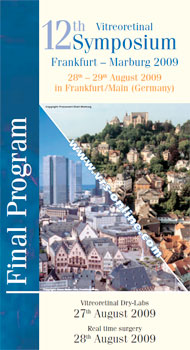12th Vitreoretinal Symposium Frankfurt – Marburg 2009
Scientific programm: Abstract
Poster
51. Effect of Bevacizumab (Avastin) versus Ranibizumab
(Lucentis) Treatment Associated with Choroidal
Neovascularization in Naïve AMD Patients
Yaprak Banu Ünver1, G. A. Yavuz2, I. Zakeri3, W. Li4, S. H. Sinclair4,5
(1Istanbul; 2Düzce; 3Philadelphia; 4Philadelphia; 5Media)
Purpose: To compare the vision and anatomic outcomes of Bevacuzimab versus Ranibuzimab monotherapy in the treatment of choroidal neovascular membrane (CNV) in naïve Age-Related Macular Degeneration patients.
Method: 23 eyes had undergone intravitreal bevacizumab whereas on 21 eyes was performed ranibuzimab monotheraphy due to active CNV due to AMD. Three consecutive injections were performed in both cohorts; prior to and at 6 months following the initial injection, the following were measured: ETDRS-Line VA, ETDRS-Letter VA and central field acuity perimetry including the best acuity within 6 degrees of fixation (BA60) and global macular acuity (GMA) along with the fluorescein parameters (CNV size, PED size, grade of leakage, grade of fibrosis, grade of atrophy, and grade of sub-retinal hemorrhage) and OCT parameters (CNV thickness, PED thickness, foveal thickness, and SRF thickness). The two cohorts were compared for all parameters using an unpaired t- test.
Results: The average age was 76.5 years in the bevacuzimab cohort, 77.8 years in the ranibuzimab group with a range of 50-98 years. No difference in the initial, final, or change in any of the vision measurements was observed between the two cohorts. There were no differences observed between the two cohorts in the initial, final or change measured in the CNV size, grade of leakage, grade of RPE atrophy, grade of CNV fibrosis or of subretinal hemorrhage. Because of insufficient PED lesions in ranibuzimab group and a large standard deviation in bevacuzimab group, PED size could not be compared. Although significant differences were noted in initial and final CNV thickness between the two cohorts, there was no difference observed in the change of CNV thickness or in the change in foveal thickness. There was also no significant difference observed in the SRF measured either initially or following treatment (P<0.05).
Conclusion: In this pilot study, both bevacuzimab and ranibuzimab appeared to produce the same effect on CNV in naïve AMD patients for all visual, fluorescein and OCT parameters measured.
Copyright © VRS-online, 1999-.
All rights reserved. Impressum, rechtliche Hinweise
HTML & Webdesign: SPALLEK.COM
